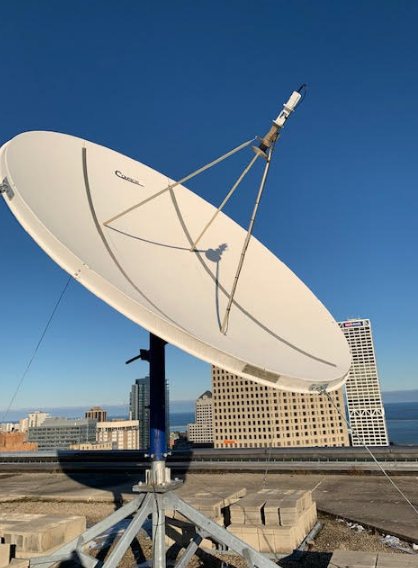The two types of smart antennas are switched beam and adaptive array antennas, each enhancing signal precision and reducing interference.
Switched Beam Antennas
Switch beam antennas are widely used in the latest innovations in the sphere of mobile communications due to the growing need for highly efficient devices. The technology of switched antennas presupposes the use of several fixed beams that cover different sectors. In cases when signals from a certain sector become stronger, the antenna system automatically switches to another sector’s beam. At that, the improved signal-to-noise ratio can reach up to 20 dB which is essential for better communication data quality.
One of the main benefits of switch beam antennas is the fact that their introduction into the cellular network reduces the number of base stations twofold. In densely populated urban areas, the implementation of switched beam antennas will lead to a 40% cut down in the number of functional base stations. This will translate into a significant economic benefit for network operators. On average, the cost of a new station’s implementation ranges from $150,000 to $200,000 in the run. The sizes of switched beam antennas are also more compact in comparison to other types of smart antennas including adaptive arrays. In most cases, the optimal measurements are considered to be around 50 cm by 50 cm for switched beam array and up to 100 cm by 100 cm for other flexibly controlled systems. Moreover, the difference in prices for the various types of antennas can amount to millions in the long run.
Tracing the disadvantages of switched beam antennas, it is important to note the decreased flexibility of handling multiple signal paths. In comparison to other more complex systems including adaptive arrays, the use of switch beam antennas with predetermined directions is less rational due to the growing number of signal paths which need processing. In different applications, this fact has a negative impact on the overall efficiency of the communication.
Adaptive Array Antennas
Adaptive array antennas address the requirements of the wireless communications sector by dynamically directing and shaping the antenna beam patterns based on signal properties. Multiple elements interact to form a directed beam whose shape is changed in response to signals based on real-time detection. The most essential aspect of all is the superior performance of adaptive arrays in the presence of multipaths, which allows adaptive arrays to achieve approximately 30 dB improvement in signal-to-interference-plus-noise ratio compared to non-adaptive antennas. This property is vital for urban settings where reflection and wave scattering on signal-blind buildings and structures can significantly disrupt the signal. Therefore, the deployment of these antennas results in increased network efficiency. In particular, since less power is wasted on areas where the energy is not needed, the same coverage can be achieved using only half of power transmission . These results also in the massive extension of the battery life of small user devices . Therefore, adaptive array antennas are a great solution in terms of operational efficiency and user convenience and experience.
Nonetheless, in terms of size, cost, and complexity, these systems can be inconvenient. Compared to simple adaptive antennas called switched beam antennas, they are massive, about 100 cm x 100cm . As for the cost, the addition of multiple antennas, complex construction, and the need for power control mechanisms, these devices can generally be 20-30% more expensive to install. At the same time, these costs are more than justified by the increase in performance. Overall, all these properties make it possible to characterize adaptive arrays as a good and durable solution. The devices are made of robust materials and operate via advanced technology, allowing them to be durable and ensuring manufacturers comply with high industry standards. Therefore, these antennas can last from 15 years or more in harsh environmental conditions. With the reduction in the number of transmitted signal wavelengths, the antenna equipment starts becoming smaller and cheaper, which can be achieved via further technology development and research in intelligent antenna design.
Gain and Directivity
Gain and directivity are key parameters defining how good an antenna is for its purpose. Gain considers how much better an antenna is at increasing the power of incoming signals into a specific direction relative to an isotropic source. Directivity, meanwhile, measures how “focused” an antenna’s radiation pattern is in comparison to being spread evenly in all directions. Both parameters are critical for determining the productivity of both signal generation and the effectiveness of the work based on that signal.
In the case of gain, a high level of it is needed for longer-range transmission and easier reception of faint signals. For example, an ordinary satellite dish has a gain of about 30 dBi to help catch the faint signals issued by satellites. A Wi-Fi router, in comparison, typically works at a gain of 5-15 dBi, enough to send a signal throughout an ordinary house or office. High-gain antennas, therefore, are more expensive and more difficult for use in most common cases . Gain by itself defines how best an antenna can direct energy in a specific direction, making it a defining factor in its efficiency.
Directivity is a measure of how well an antenna focuses its radiated power in a specific direction. Increased directivity can be vital in certain types of use, with point-to-point links serving as a good example . Ordinary pipelike antennas, for example, have a theoretical maximum directivity of 6 dBi, although their standard working directivity is lower. A mid-level directivity number for a directional point-to-point antenna would be about 20 dBi, ensuring that the minimum amount of radiated power is wasted in other directions, making the link as good as it can be, and further cutting power requirements. Directivity changes in correspondence to the inverse cube of the distance, so a 3 dB increase would double the maximum distance achievable by the transmission.
The gain and directivity are dependent on the material, transmission medium, and the antenna’s design. Metallic antennas are most common, with bi-metallic base designs being consisted of copper and aluminum, a perfect material for its conductive properties and transmitting ability. Adding copper, known to be an even better medium for signal transmission, can also lead to a higher-grade antenna overall. Similarly, the size, shape, and number of elements can all influence the gain directly – a Yagi-Uda antenna will be high-gain and high-directivity at the same time when it has many long elements. Higher-gain antennas are more complex and expensive $(100-400).

Interference Reduction Capabilities
Interference reduction is among the most critical features of modern antenna systems. Smart antennas are particularly good at this because their adaptive beam pattern allows them to avoid interference efficiently. Interference may occur when communication systems deployed in crowded electronic environments, such as cities, end up using the same frequencies. Consequently, smart antennas such as the adaptive array antennas can pinpoint the location, trajectory, and timing of their corresponding signals and manage these beams to enhance the field strength needed. Simultaneously, the antennas can null out direction off of which no signal is coming . It is notable that adaptive beam antenna systems have been known to reduce interference by up to 40% compared to traditional beam management technologies, such as matching antennas. Beamforming is a critical technology for measuring how good an antenna is at dodging interference. Beamforming technology involves measuring the pattern of beam intensity or half-power identified within the beam of interest . The spread of energy by an antenna across space results in the signal strength being low on the beam axis and high on the beams of interest.
When energy is transmitted or received within a beam of interest, and the other portions are likely to be of interest, then the power consumption will be low. Beamforming is essential because an increased number of beams is equivalent to the transmission of more data on the same frequency band. If beamforming was not used in 5G transmission systems, approximately a third of the required landmarks would be used in limiting photographs. It, therefore, follows the importance of using quality materials in the manufacture of systems to avoid data loss from diversifying on entire geographical areas. A system with an advanced beamforming capacity would save the user a third of the needed landmarks. A less complicated measurement system such as the half-power beamwidth specification would also be used. It would also be cheaper to produce and maintain such a device.
Overall, an antenna’s ability to reduce interference is largely contingent on the technology used. Specialising in materials with better electrical properties such as silver plating and copper. The investment would result in improved design and performance quality, but the cost of producing such a device to an optimal extent would be greater. The higher cost would be ultimately worth it because the device’s reliability is critical. The cost is, in my opinion, justifiable for military and air traffic control applications because there is little room for antenna interference.








